I didn't take as many notes as I should have, when author Shannon Hale "visited" KidLitCon on our second day. Mainly because I was on edge, hoping against hope that the Skype would stay hooked up (it didn't) and that laptop wouldn't blow up (oddly enough, it kind of did. Was it because I was thinking about that??), and that all would go well (somehow, in the end, it did). I regret that lack of note-taking and apologize for it.

Even if you've never met her, reading her blog will reveal a Shannon Hale who comes across as such a lovely, genuine person. I appreciated much of what she had to say. She gave us a little background about who she is, and how she came to support greater diversity in children's literature. While sharing a personal experience, she spoke movingly about the lone girl she imagined needed her stories - and the variations on that girl that she has met, the one little girl who looked at a Hale book and said, "Oh, that girl is just like me," and whatever her color, truly believed it. She also talked about moving to a high school and going from being in the majority to being a definite minority, and what an unusual and freeing experience that was for her. She talked about what a hoot THE GREAT GREEN HEIST had been for her, and how much she'd loved the cover, filled with faces across the (human pigment) color spectrum.

But, there was one thing Shannon Hale said that caught me right across the solar plexus, that made me strain vainly to catch my breath (and I wonder if I am making this up, or if I was the only one who heard it, because I'm a little surprised no one else has blogged about it. Guys, seriously: did I hallucinate this???). She said, and this is not a quote, because I didn't take good notes, that books with nonwhite characters on the covers don't sell as well as those with white characters on the covers. Shannon went on to explain how she'd seen that as truth with her own books, that sales of the arms-and-hands girl on the hardcover version of BOOK OF A THOUSAND DAYS sold much, much better than the paperback whereon the whole of the girl with Asian arms, hands and features was revealed.
...wait, what?
BOOM. Sucker punch.
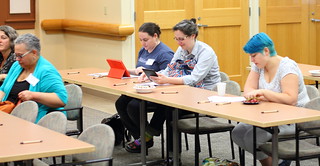
Further, Hale explained, the sidekick character in Rapunzel's Revenge was nonwhite, and the sequel, which starred him on the front cover, has sold poorly in comparison to the first, with Rapunzel in her titian-haired glory on the front cover.
This is where I started taking notes... much of which did not make all that much sense:
* You can't compare apples and apples! I scribbled. (I'm pretty sure I meant "apples and oranges." Or kiwis. Or, ooh - let's go with star fruit - the star fruit on the a.m. snack buffet was really good. Okay, back on topic.)* Different market conditions between Rapunzel 1 & 2, I added.
* Could be anything: change of narrator = ugh?
* Is "white" vs. "other" all that matters? if "white" is all what sells, ...sad, shrug? Must be answer for this - parents, teachers, librarians ==>readers.
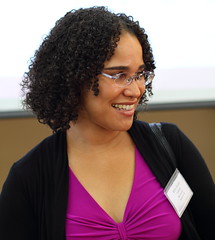
To decode: two like things cannot effectively be compared. True, Hale's BOOK OF A THOUSAND DAYS were in paperback and hardback form, but: the two books were sold at different times; there's the possibility that everybody had already gotten their copy of the book, in hard-back, and didn't need or want a second copy; the marketing would have been different, as would its placement within bookstores; etc. The only way for this kind of "test" to be fair would be to test the same book - with the same price - and different covers, either in the same store, or in different regions.
Further, in referencing the Rapunzel books, the issue of poor sales for the sequel might have been something as simple as... It was a sequel. There was a change in narrator. Maybe it came out in the summertime, the springtime, the autumn, when school just started, deep winter, post-Holiday blahs.... In short, there could have been all sorts of reasons.
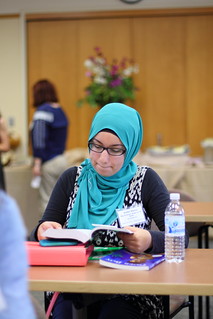
Slightly on-topic example: I really love Seanan McGuire's bizarre InCryptid series. I haunted my library for them, and actually bought and donated a couple when they were too (*cough*) slow procuring them, and then I saw the cover of the third one, and I hit a wall. Half-Off Ragnarok. Had a boy. On the cover. No, no. NO. My favorite insouciant and smarty pants narrator is a girl, Verity Price. Some dude? I didn't even wanna know. I put that book aside for an embarrassingly long time, out of sheer pique. I didn't want to read it, because Who Was This Alex Person, Anyway? In the end, Alex was hilarious and just fine. It just... took me a minute. Readers - even dream readers like me (*cough*) sometimes choke when an author changes things in a series. So, case in point, with Ms. Hale's sequel? It could have been something that simple which affected sales.
My point? There is not enough data to generate meaningful information in response to questions about what sells better. Giving credence to this evidence-free argument is another way to hide behind the idea that The Market is to blame for z, y, and x. The Market did it. It's not anyone's problem but The Market's. Just sort of summarizing like that makes the issue of publishing's diversity pitfalls all so much less... distinct and specific, and I think Shannon Hale erred when she gave credence to a free-floating publishing paranoia that will neither get data nor die, as my friend and fellow author Ashley H. Pérez puts it.

It wasn't the most coherent rant there in my notes, especially that last bit ("sad shrug" - ??), but I've still kept thinking about Hale's talk. And thinking about it. And, thinking, this is ridiculous (not Shannon Hale's talk - this publishing thing). Ashley is right -- we need to either get data, hard data, or we need to let this one die. And, we need to think ahead -- because if we GET the data that says definitively that books with nonwhite characters on the covers don't sell, is the answer really to close up shop and say, "Welp, the colored people gave it their best shot, better go home now" -- ??? REALLY?
No.
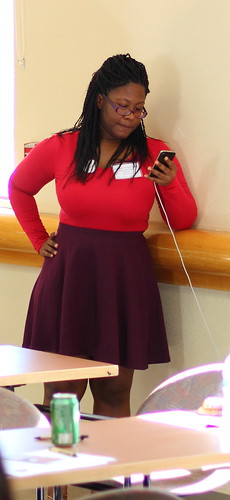
A problem exists, and it is systemic - involving us all - teachers, librarians, readers, writers, publishers, bloggers, reviewers - and I think it's not going to sort itself until all of us are involved. I also think that people in the dominant culture are simply given what it's assumed that they want, which is a world that appears to be a monoculture - which is then what they buy - which revolves around itself like an ouroboros, as bookstores stock those books, which then are the books purchased over others, and it goes on, and on, and on. A monoculture is certainly an easier world to find, in stock-photographyland, which is from where a great many book covers come, and certainly businesses are all about easy and inexpensive. Art? Individual photo shoots? The money those things represent is pretty significant.
I know the challenges. But, I still can't blindly give credence to the evidence-free argument that books with diverse and multicultural people on the covers don't sell. I appreciated Elizabeth Bluemle's perspective a few years back. She lives in Vermont, one of our smallest states which is 93.4% White, as of the 2010 census, and somehow manages to stock and sell diverse books in her tiny bookstore.

For this issue to be resolved, someone (meaning: someone with proper research chops, plus a willing publisher, READ: not Sarah and me - CBC? Knopf? Horn Book? Anyone?) needs to put together an experiment wherein a book is distributed with two different covers: one with a Caucasian-looking character, and one with a non-white character, with everything else exactly the same. Whether the two versions go to the same stores, or whether they separate out the covers to different distributors, I don't know. I do know, however, that we need an answer, and there ought to be people who are interested in studying the problem, if only we could find them. If we truly seek the answer, we can then move forward (and there is a "forward" to move to, for sure. Simply identifying the needs for diversity isn't enough). If it turns out that there is no effect, one way or another on sales with diverse or non-diverse covers, then we can argue that much more strongly for more diversity in cover art. If it turns out that the American public is racist in their purchasing ... well, we can at least know for certain, identify our lack, and make a specific and pointed campaign to effect change. Either way, though, it is my heartfelt wish for argument from evidence rather than from gut-feelings and suspicion.
Meanwhile, I, as blogger, will continue to blog about what's important to me - diversity - just as Shannon Hale, in her less floaty, smaller head incarnation, will continue to think about and write stories whose diversity, energy and imagination captures ours.

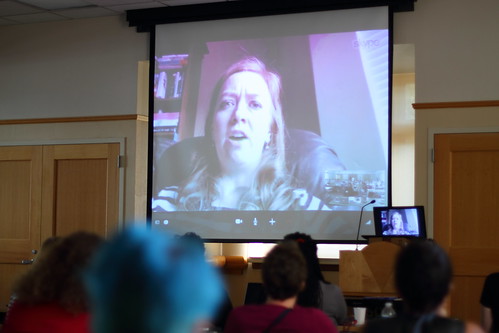

2 comments:
Yeah, when I heard Shannon say that about the paperback not selling as well....all the other things that could have come into play kicked in (like her fans having bought in hardcover, the hardcover being more viscerally attractive to the book lover (in my opinion), the paperback looking like Serious Historical Fiction, the hardcover having not sold as well as hoped and so little marketing for the paperback....all those other things.
Now Jewell Parker Rhodes' new book has a cover with a lovely black girl and the whole design has kid appeal to spare, and she's a major author and her publisher seems to be behind the book (we got sent copies!) and it looks like fantasy in our world, and not like it is historical fiction (about, say, slavery) and so should appeal to the kids who want that, and it hasn't been out in any other edition...and so I am really really curious to see if it will sell well!
And I hope it does.
@Charlotte: THANK YOU for confirming that was actually said. I know we were somewhat brain dead from sitting in a dimmed room - but I swear I feel like I'm the only one who remembers what was said - and maybe it's MY FAULT for not standing up and saying, "Hey! PROVE IT," when she said what she did, but a.) I am rarely articulate upon the moment and b.) I really do better in writing, and c.) I kept waiting for her to clarify what she meant... and then she went on to something else. And I wondered if I'd misunderstood.
ESPECIALLY with a fairytale retelling or a fantasy story, it's a shame to not let the imagined be diverse, and I do think that because it doesn't look like "oh, same old slavery story," that Ms. Jewell's book is going to fly off of shelves.
Post a Comment